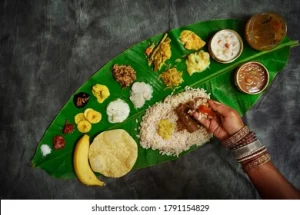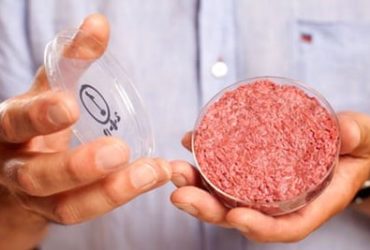Going Bananas!
The science and tradition of eating on banana leaves
By : Prerana Balasubramanian
What do Nasi lemak, tamales and Liboké de Poisson have in common? All of them are cooked in leaves. Cooking and eating on leaves has been adapted by different cultures and dishes all around the world – let’s explore why.

Image 1: A meal cooked in a banana leaf
One of my fondest childhood memories growing up in South India is eating a huge feast on a banana leaf during family gatherings or festivals. Grown in more than 150 countries, it is widely believed there are more than 1,000 types of bananas in the world. But did you know that apart from the fruit, the leaf is big enough to serve a multi course meal? From Mexico to Hawaii to North Africa to inner Laos to south, east, and west India – around the world, wherever bananas grow, our ancestors have devised ways to use these giant leaves. Banana leaf is not the only “natural tableware” out there – bamboo, grape, lotus, corn husks and perilla leaves have been known to cook, wrap or serve food in different cultures around the world. But there is something special about the banana leaf. As described by Eames, it is the “the simplest and most refined container for food”, we use them to wrap and cook foods both savory and sweet. It is still a common practice in several Indian households owing to its nativity, abundance throughout the year and of course health benefits.
My grandmother has a few banana trees growing in her backyard, and before lunch, a few large leaves are plucked to prepare food. Owing to their waxy surfaces, the leaf prevents dirt and dust from sticking to the leaves. To make them easy to maneuver, the leaves are cleaned, cut into smaller pieces, and run over a flame to make them pliable. This also melts the wax and releases the natural oils which make them fragrant, shiny, and glossy. It is said that banana leaves are a source of flavonoids, polyphenols, saponins, and tannins that are released when hot food is cooked in them. This not only contributes to its medicinal value but makes them very hygienic to use. When I go visit my grandma, she always prepares a traditional delicacy called Ela Ada – rice pancakes filled with fresh grated coconut and jaggery. Getting these dishes ready is a very hands-on experience that requires encasing the dough and neatly parceling into the leaf and steaming. The leaves are versatile for steaming, boiling, frying, baking, or grilling foods. It holds the heat in and protects the food from losing its natural flavor. Freshly steamed and warm to touch, these packages of nostalgia are one of my favorite dishes to eat. The experience of eating from a banana leaf is indeed a multisensorial one – involving touch, sight, and taste.

Image 2: Banana leaf platter – a sensational multi-course vegetarian meal that features over 24 dishes on a banana leaf.
In terms of medicinal value, banana plants have been used orally or topically as remedies in folk medicine and some studies have demonstrated this medicinal potential. The leaves contain an enzyme called polyphenol oxidase that produces L-DOPA that counteracts the action of free radicals, used in the treatment for Parkinson’s disease. Studies in animal models have also shown banana leaves are an excellent source of rutin, which modulates glucose homeostasis and is a good candidate for the development of anti-diabetic drugs.
The versatility of the leaf is not just restricted to serving plates. There are several businesses that have combined this humble and unapologetically traditional practice with modern processing techniques to use as cups, bowls and food wraps that can substitute plastic. Companies like Bio Plant Peru and Banana Leaf Technology India are looking to develop new technologies to make their products more durable and cost effective. As individuals are looking for options to be more sustainable in their day to day lives – natural fiber dinnerware offers the advantage of being eco-friendly, hygienic, and practical but also chemical-free. A recent article titled – “Why banana leaves are my hope for a sustainable future” highlights the transformative changes using renewable resources such as banana leaves can help us create a world with no plastic in nature by 2030.

Image 3: Banana leaf packaging at the Rimping supermarket in Chiangmai, Thailand (2019)
Image credit : Perfect Homes Chiangmai
Looking back at the past, we often see examples of how limited resources have forced creative solutions for our everyday problems and needs – taking inspiration from nature around us. Banana leaves have a cultural, traditional, symbolic, emotional, ritual, mystical and spiritual significance in different cultures around the world. There is a flourishing commercial market for banana leaves as a natural resource and as a not-so-new solution for packaging. With the number of innovations currently in the way to design – the Banana leaf 2.0 is addressing the current challenges of environmental footprint, cost and resource availability, can we soon hope to see the humble banana leaf in a grocery store near you?
References
- Eames, C., & Eames, R. (1972). Banana Leaf (Short film). https://www.imdb.com/title/tt0286481/
- https://ift.onlinelibrary.wiley.com/doi/pdf/10.1111/1750-3841.15854
- Firdous, Jannathul, et al. “Enzymatic analysis and effect of vermicompost production from banana leaves waste using epigeic earthworm eudrillus euginea.” Nature Environment and Pollution Technology 18.4 (2019): 1305-1311.
- https://www.worldwildlife.org/stories/why-banana-leaves-are-my-hope-for-a-sustainable-future
- https://www.forbes.com/sites/trevornace/2019/03/25/thailand-supermarket-uses-banana-leaves-instead-of-plastic-packaging/?sh=3f7503ae7102
- Featured Image: https://pixabay.com/photos/meal-enjoy-the-meal-banana-leaf-52075/
- Image 1: https://www.pexels.com/photo/tamal-en-hoja-de-platano-14179987/
- Image 2: https://image.shutterstock.com/image-photo/kerala-onam-feast-eating-onasadya-260nw-1791154829
- Image 3: https://imageio.forbes.com/blogs-images/trevornace/files/2019/03/banana-leaves-packaging-1200×900.jpg?format=jpg&width=960
 About the Author:
About the Author:
Prerana Balasubramanian
I’m a final year biotechnology undergraduate at Vellore Institute of Technology, India by training with a particular interest in food science and the smart protein sector. As a conscious consumer, I like thinking of ways I could reimagine foods to be more nutritious, tasty and have a lower environmental footprint while respecting our food traditions. I aspire to use the unique mixture of my food science knowledge and biotechnology background to tackle complex food challenges across the food chain.






Leave a Reply